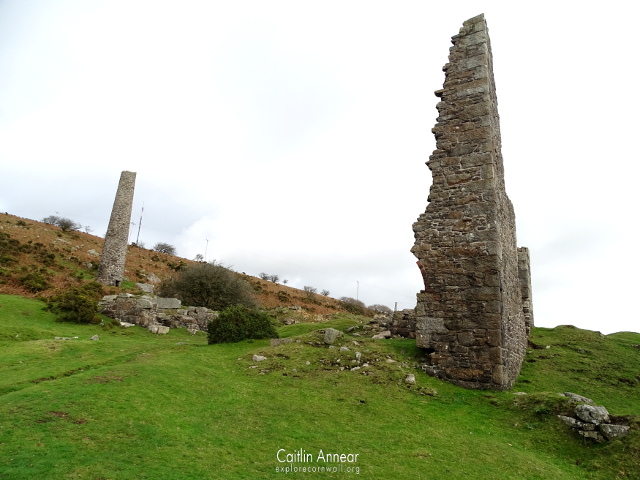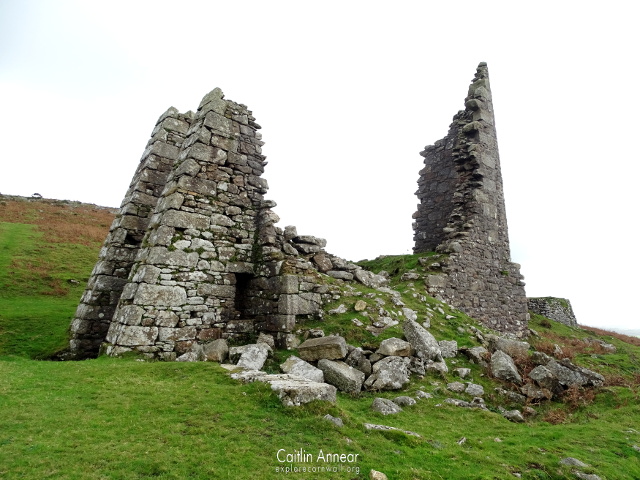All along the southern side of Caradon Hill are the extensive remains of South Caradon Mine.

Holman’s (New Engine) 70″ pumping engine.
Unlike other areas of Cornwall where mining dates back to antiquity under the Old Men, the history of the Caradon area is a much more recent one. Though there is evidence of tin streaming and no mind appears to have been given to the potential for more ore underneath the ground until the 1830’s. Once work did begin, it didn’t take long before this whole area became one of the most profitable in the county, at times outstripping some much more famous mines further west.

The 50″ pumping engine on Sump shaft.
In 1833 a new adit was being driven by Captain James Clymo, striking rich copper. The actual mine itself was recorded three years later, starting its short but very profitable career. By 1846 the mine was reached by the Liskeard and Caradon Railway, joining it with the Liskeard and Looe Union Canal.
Throughout the 1850’s and 60’s South Caradon mine hit its heyday. During this period over 600 people were employed over its extensive sett as it quickly became the third largest producer in Cornwall, raising over 165,000 tons of ore in 1868. South Caradon Mine had over a dozen steam engines, shafts over 200 fathoms deep, with miles of levels, stopes and cross-cuts. It’s sheer size was the only thing that appeared to save the mine during a slump in copper prices during the next five years. However, despite its continued high copper output, the prices remained very low and its financial security was under threat. In 1880 work stopped.

On the right is all that’s left of the 40″ pumping engine on Rule’s shaft, to the left is the remains of the 24″ whim which served both Rule’s and Holman’s shafts.
In 1883 after stumping up £16,125 (£1,067,228 now) to by the old machinery, South Caradon Ltd was formed to try and rework the former mine. Many of the old engines needed substantial refurbishment, and this venture was short lived, coming to a close just five years later. The final attempt was in 1888 when it was worked alongside many of its neighbours under Glasgow Caradon Co Ltd to try and capitalise on rising copper prices, but this only lasted for two years.
Jope’s (140 fathoms/256m), Sump/ Old Engine (250 fathoms/457m), Pearce’s (100 fathoms/183m), Clymo’s (120 fathoms/219m), Kitto’s (SE on Caunter lode: 210 fathoms/384m; NW on Kitford’s lode: 110 fathoms/201m; N on flat dip: 60 fathoms/110m), Rule’s (180 fathoms/329m) and New Engine/Holman’s (230 fathoms/421m).
Caunter, Main/Allan’s, Clyma’s, Jope’s, Kitford’s and Holman’s/South Kitto’s.
1838-1885
224,656 tons (228,261,034 kg) of 10% copper (Nance, Brown and Clarke)
or
217,820 tons (221,315,338 kg) of 10% copper (Dines).

The remains of the 30″ stamps engine chimney
South Caradon Mine had a lot of engine houses and many of them have an interesting history.
Jope's Shaft
Pumping Engine
Originally built in the 1850’s for a Sim Engine (one of only four left in Cornwall), this was replaced by a 60″ in 1862. This engine dates from 1855 where it was at work at South Garras mine.
Whim Engine
Bought from St Blazey Foundry in 1863, this 23″ whim started work in 1864. In 1872 it was modified by William West to drive a man engine which was eventually moved to Kitto’s shaft in 1884.
Kitto's Shaft
Whim Engine
Erected on the shaft between 1882-3 with a 22″ engine.
Pumping Engine
A 35″ pumping engine, of which parts of the bob wall remains. This was erected between 1862-4.
Man Engine
This was a 23″ engine which originally came from Jope’s shaft in 1883.
Pearce's Shaft
Pumping Engine
A 50″ engine was erected on this shaft in 1870 and came from Harvey’s of Hayle. This is a unique little engine in that it has two buttresses, built this way because the shaft was sunk at an angle away from the house, the reason for which is a mystery.
Sump Shaft
Pumping Engine
A 45″ engine was erected here in 1837, but was later upgraded to a 50″ sometime after 1863.
Whim Engine
This was a 22″ West engine that was likely erected in 1840 to start work in 1844. This also pumped from Pearce’s shaft via flatrods until the pumping engine was built here.

Rule's Shafts
Pumping Engine
A 40″ engine was erected in 1863. Only part of the house remains due to another military demolition exercise, which has struct other mines (Killifreth, Wheal Busy and Boswedden).
Whim Engine
This was a 24″ horizontal single cylinder engine which had two winding drums so that it could serve both Rule’s and Holman’s shafts.
Holman's Shaft
This was a 70″ Harvey’s engine erected in 1875 to help the older engine on Rule’s shaft to drain the deeper parts of the mine.
Stamps Engine
At the bottom of the sett alongside the river is the lone chimney which once belonged to a 30″ stamps engine. This was erected in 1862 to replace a 26″ stamps from 1844 to drive 24 heads of stamps.

The whole of the mine is free for everyone to access along public footpaths and common land. As it’s common land, there are plenty of free-range sheep around, so be mindful if you take a dog with you to view these beauties.
There is plenty of free parking in the village of Minions.
Brown, K. and Acton, B. (2007) Exploring Cornish Mines: Volume Two. 2nd edn. Truro: Landfall Publications.
Dines, H. G. (1956) The metalliferous mining regions of south-west England. British Geological Survey.
Hamilton-Jenkin, A. K. (1966) Mines and Miners of Cornwall: XII Around Liskeard. Truro: Truro Bookshop.
Nance, D., Brown, K. and Clarke, T. (2019) A Complete Guide to the Engine Houses of Mid-Cornwall. Lydney: Lightmoor Press.







